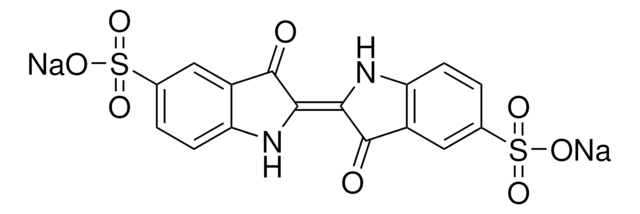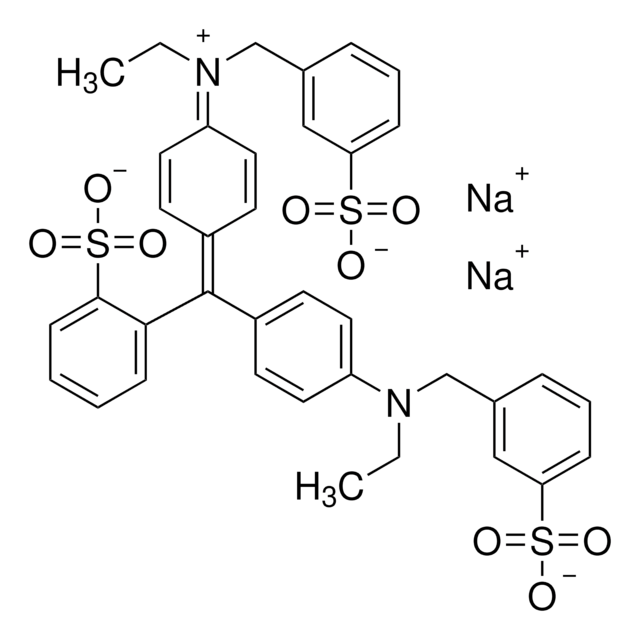81240
Poli(etilenglicol)
average Mn 4,000, hydroxyl
Sinónimos:
PEG
Iniciar sesiónpara Ver la Fijación de precios por contrato y de la organización
About This Item
Fórmula lineal:
H(OCH2CH2)nOH
Número de CAS:
MDL number:
UNSPSC Code:
12352104
PubChem Substance ID:
NACRES:
NA.23
Productos recomendados
product name
Poli(etilenglicol), average Mn 4,000, platelets
biological source
platelets
Quality Level
form
powder
mol wt
Mn 3,500-4,500
average Mn 4,000
mp
58-61 °C
Ω-end
hydroxyl
α-end
hydroxyl
SMILES string
C(CO)O
InChI
1S/C2H6O2/c3-1-2-4/h3-4H,1-2H2
InChI key
LYCAIKOWRPUZTN-UHFFFAOYSA-N
¿Está buscando productos similares? Visita Guía de comparación de productos
General description
Polyethylene glycol (PEG) is a hydrophilic polymer. It can be easily synthesized by the anionic ring opening polymerization of ethylene oxide, into a range molecular weights and variety of end groups. When crosslinked into networks PEG can have high water content, forming “hydrogels PEG is a suitable material for biological applications because it does not trigger an immune response.
Application
Polyethylene glycol (PEG) platelets were used:
- in PEG-directed gene delivery of protoplast transfection and incubation
- to prepare extraction for measuring cytosolic phosphoenolpyruvate carboxykinase (PEPCK) from plant tissues
- as DNA transformation agent in a study of transient gene expression of plant protoplasts, derived from rice leaf sheaths.
- in preparing isothermal assembly buffer and TSS broth preparation for unique nucleotide sequence (UNS)-guided assembly of repetitive DNA parts
- in transformation of DNA into log-phase cells of the budding yeast Saccharomyces cerevisiae.
- as DNA transformation reagent
Other Notes
Polymer networks with grafted cell adhesion peptides for highly biospecific cell adhesive substrates
Storage Class
11 - Combustible Solids
wgk_germany
WGK 1
flash_point_f
Not applicable
flash_point_c
Not applicable
ppe
Eyeshields, Gloves, type N95 (US)
Elija entre una de las versiones más recientes:
¿Ya tiene este producto?
Encuentre la documentación para los productos que ha comprado recientemente en la Biblioteca de documentos.
Los clientes también vieron
Oleg Raitskin et al.
PloS one, 14(2), e0211598-e0211598 (2019-02-28)
Molecular tools adapted from bacterial CRISPR (Clustered Regulatory Interspaced Short Palindromic Repeats) systems for adaptive immunity have become widely used for plant genome engineering, both to investigate gene functions and to engineer desirable traits. A number of different Cas (CRISPR-associated)
Shen, Jinbo, et al. "Isolation, culture, and transient transformation of plant protoplasts
Shen J, et al.
Current Protocols in Cell Biology, 2014, 2-8 null
A simple and effective method to encapsulate tobacco mesophyll protoplasts to maintain cell viability
Lei R, et al.
Methods, 24-32 (2015)
Jennifer DeMars Tripp et al.
Yeast (Chichester, England), 30(5), 191-200 (2013-03-14)
Chemical-based methods have been developed for transformation of DNA into log-phase cells of the budding yeast Saccharomyces cerevisiae with high efficiency. Transformation of early stationary-phase cells, e.g. cells grown in overnight liquid cultures or as colonies on plates, is less
Frédéric Sanchez et al.
Genes, 10(5) (2019-05-28)
Ostreococcustauri is an easily cultured representative of unicellular algae (class Mamiellophyceae) that abound in oceans worldwide. Eight complete 13-22 Mb genomes of phylogenetically divergent species within this class are available, and their DNA sequences are nearly always present in metagenomic
Nuestro equipo de científicos tiene experiencia en todas las áreas de investigación: Ciencias de la vida, Ciencia de los materiales, Síntesis química, Cromatografía, Analítica y muchas otras.
Póngase en contacto con el Servicio técnico




